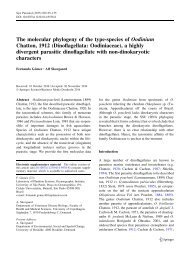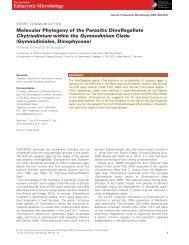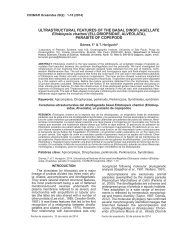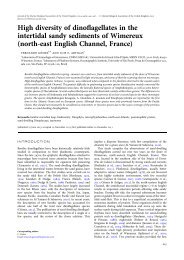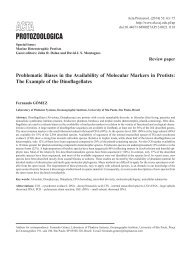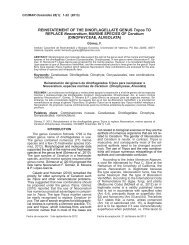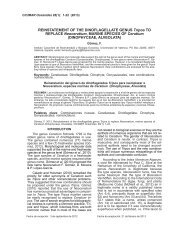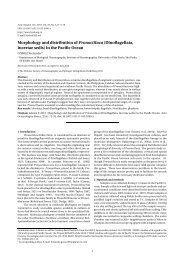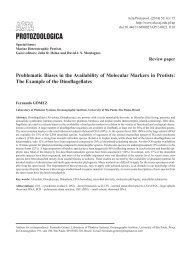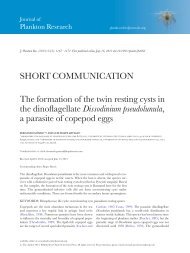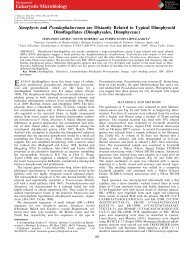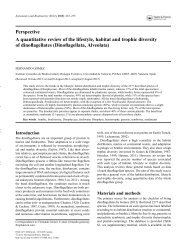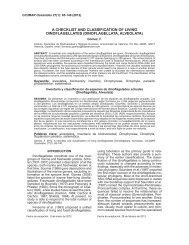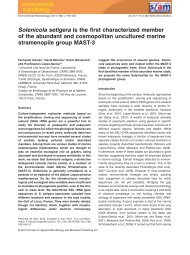Molecular phylogeny of the dinoflagellates Podolampas and Blepharocysta
In contrast to the typical peridinioid dinoflagellates, the podolampadaceans are characterised by the absence of both a cingulum and a depressed sulcus. Until now, gene sequences for typical core podolampadaceans were not available. Despite this, two genera that appeared related in small subunit rRNA gene (SSU rDNA) trees, the sand-dwelling Roscoffia and Lessardia, which was previously considered an unarmoured taxon, were ascribed to this group since they showed coincidences in the plate formula with the podolampadaceans. However, the classification of Lessardia and Roscoffia as podolampadaceans remains controversial. To test whether these two genera are actually podolampadaceans, we obtained the first SSU rDNA sequences of four species of Podolampas (the type P. bipes, and P. elegans, P. palmipes and P. spinifera) and a Blepharocysta species, morphologically similar to the type B. splendor-maris, from the type locality, western Mediterranean Sea. SSU rDNA phylogenies showed that podolampadaceans and Roscoffia formed a well-supported monophyletic group composed of two subclades: one for Roscoffia and Blepharocysta and one other for Podolampas species. The whole podolampadacean clade branched in the lineage comprising Gymnodiniales, Peridiniales and Prorocentrales. By applying different methods and taxon sampling, we obtained alternative obtained alternative branching topologies. Either the podolampadaceans branched with low statistical support with Heterocapsa, Scrippsiella and Peridinium, while Lessardia branched relatively far with other peridinioids, or Lessardia branched as sister clade of the podolampadaceans with moderate support. The position of Lessardia appeared to be very instable, largely depending on the taxonomic sampling used. Although members of the Diplopsalis group have been suggested as ancestors of the podolampadaceans, our SSU rDNA phylogenies did not support a close relationship between both clades.
In contrast to the typical peridinioid dinoflagellates, the podolampadaceans are characterised by the absence of both a
cingulum and a depressed sulcus. Until now, gene sequences for typical core podolampadaceans were not available.
Despite this, two genera that appeared related in small subunit rRNA gene (SSU rDNA) trees, the sand-dwelling
Roscoffia and Lessardia, which was previously considered an unarmoured taxon, were ascribed to this group since they
showed coincidences in the plate formula with the podolampadaceans. However, the classification of Lessardia and
Roscoffia as podolampadaceans remains controversial. To test whether these two genera are actually podolampadaceans,
we obtained the first SSU rDNA sequences of four species of Podolampas (the type P. bipes, and P. elegans, P.
palmipes and P. spinifera) and a Blepharocysta species, morphologically similar to the type B. splendor-maris, from the
type locality, western Mediterranean Sea. SSU rDNA phylogenies showed that podolampadaceans and Roscoffia
formed a well-supported monophyletic group composed of two subclades: one for Roscoffia and Blepharocysta and one
other for Podolampas species. The whole podolampadacean clade branched in the lineage comprising Gymnodiniales,
Peridiniales and Prorocentrales. By applying different methods and taxon sampling, we obtained alternative obtained
alternative branching topologies. Either the podolampadaceans branched with low statistical support with Heterocapsa,
Scrippsiella and Peridinium, while Lessardia branched relatively far with other peridinioids, or Lessardia branched as
sister clade of the podolampadaceans with moderate support. The position of Lessardia appeared to be very instable,
largely depending on the taxonomic sampling used. Although members of the Diplopsalis group have been suggested as
ancestors of the podolampadaceans, our SSU rDNA phylogenies did not support a close relationship between both
clades.
Create successful ePaper yourself
Turn your PDF publications into a flip-book with our unique Google optimized e-Paper software.
Phycologia (2010) Volume 49 (3), 212–220 Published 3 May 2010<br />
<strong>Molecular</strong> <strong>phylogeny</strong> <strong>of</strong> <strong>the</strong> din<strong>of</strong>lagellates <strong>Podolampas</strong> <strong>and</strong> <strong>Blepharocysta</strong><br />
(Peridiniales, Dinophyceae)<br />
FERNANDO GÓMEZ 1 *, DAVID MOREIRA 2 AND PURIFICACIÓN LÓPEZ-GARCÍA 2<br />
1 Marine Microbial Ecology Group, Université Pierre et Marie Curie-Paris 6, CNRS UMR 7093, Laboratoire d’Océanographie<br />
de Villefranche, Station Zoologique, BP 28, 06230 Villefranche-sur-Mer, France<br />
2 Unité d’Ecologie, Systématique et Evolution, CNRS UMR 8079, Université Paris-Sud, Bâtiment 360,<br />
91405 Orsay Cedex, France<br />
GÓMEZ F., MOREIRA D. AND LÓPEZ-GARCÍA P. 2010. <strong>Molecular</strong> <strong>phylogeny</strong> <strong>of</strong> <strong>the</strong> din<strong>of</strong>lagellates <strong>Podolampas</strong> <strong>and</strong><br />
<strong>Blepharocysta</strong> (Peridiniales, Dinophyceae). Phycologia 49: 212–220. DOI: 10.2216/09-29.1<br />
In contrast to <strong>the</strong> typical peridinioid din<strong>of</strong>lagellates, <strong>the</strong> podolampadaceans are characterised by <strong>the</strong> absence <strong>of</strong> both a<br />
cingulum <strong>and</strong> a depressed sulcus. Until now, gene sequences for typical core podolampadaceans were not available.<br />
Despite this, two genera that appeared related in small subunit rRNA gene (SSU rDNA) trees, <strong>the</strong> s<strong>and</strong>-dwelling<br />
Rosc<strong>of</strong>fia <strong>and</strong> Lessardia, which was previously considered an unarmoured taxon, were ascribed to this group since <strong>the</strong>y<br />
showed coincidences in <strong>the</strong> plate formula with <strong>the</strong> podolampadaceans. However, <strong>the</strong> classification <strong>of</strong> Lessardia <strong>and</strong><br />
Rosc<strong>of</strong>fia as podolampadaceans remains controversial. To test whe<strong>the</strong>r <strong>the</strong>se two genera are actually podolampadaceans,<br />
we obtained <strong>the</strong> first SSU rDNA sequences <strong>of</strong> four species <strong>of</strong> <strong>Podolampas</strong> (<strong>the</strong> type P. bipes, <strong>and</strong>P. elegans, P.<br />
palmipes <strong>and</strong> P. spinifera) <strong>and</strong> a <strong>Blepharocysta</strong> species, morphologically similar to <strong>the</strong> type B. splendor-maris, from <strong>the</strong><br />
type locality, western Mediterranean Sea. SSU rDNA phylogenies showed that podolampadaceans <strong>and</strong> Rosc<strong>of</strong>fia<br />
formed a well-supported monophyletic group composed <strong>of</strong> two subclades: one for Rosc<strong>of</strong>fia <strong>and</strong> <strong>Blepharocysta</strong> <strong>and</strong> one<br />
o<strong>the</strong>r for <strong>Podolampas</strong> species. The whole podolampadacean clade branched in <strong>the</strong> lineage comprising Gymnodiniales,<br />
Peridiniales <strong>and</strong> Prorocentrales. By applying different methods <strong>and</strong> taxon sampling, we obtained alternative obtained<br />
alternative branching topologies. Ei<strong>the</strong>r <strong>the</strong> podolampadaceans branched with low statistical support with Heterocapsa,<br />
Scrippsiella <strong>and</strong> Peridinium, while Lessardia branched relatively far with o<strong>the</strong>r peridinioids, or Lessardia branched as<br />
sister clade <strong>of</strong> <strong>the</strong> podolampadaceans with moderate support. The position <strong>of</strong> Lessardia appeared to be very instable,<br />
largely depending on <strong>the</strong> taxonomic sampling used. Although members <strong>of</strong> <strong>the</strong> Diplopsalis group have been suggested as<br />
ancestors <strong>of</strong> <strong>the</strong> podolampadaceans, our SSU rDNA phylogenies did not support a close relationship between both<br />
clades.<br />
KEY WORDS: Din<strong>of</strong>lagellata, Diplopsalid, Gymnodiniales–Peridiniales–Prorocentrales lineage, Heterotrophic din<strong>of</strong>lagellate,<br />
Lessardia, Rosc<strong>of</strong>fia, SSU rDNA <strong>phylogeny</strong><br />
INTRODUCTION<br />
The members <strong>of</strong> <strong>the</strong> family Podolampadaceae Lindemann<br />
have unique characteristics among <strong>the</strong> <strong>the</strong>cate din<strong>of</strong>lagellates,<br />
such as a cryptic cingulum <strong>and</strong> <strong>the</strong> absence <strong>of</strong> an<br />
apparent sulcus (Carbonell-Moore 1994a). Because <strong>of</strong> <strong>the</strong>se<br />
peculiarities, <strong>the</strong> plate formula <strong>of</strong> <strong>the</strong> podolampadaceans<br />
has been described in many different ways, depending on<br />
whe<strong>the</strong>r <strong>the</strong> authors consider <strong>the</strong> three large plates in <strong>the</strong><br />
lower cell half to be <strong>the</strong> three cingular plates found in<br />
peridinioids (Balech 1963, 1988) or as postcingular plates<br />
(Abé 1966). Carbonell-Moore (1994a) redefined <strong>the</strong> plate<br />
formula <strong>of</strong> <strong>the</strong> podolampadaceans based on <strong>the</strong> plate<br />
homology comparison with <strong>the</strong> hypo<strong>the</strong>ca <strong>of</strong> members <strong>of</strong><br />
<strong>the</strong> Diplopsalis group with one antapical plate. The plate<br />
formula was written as Po, Pt, X, 39, 1a,50, 3C 4-5S, 4-509,<br />
100, instead <strong>of</strong> 2-309, 300. This author suggested that <strong>the</strong><br />
diplopsalids ‘are ancestors’ <strong>of</strong> <strong>the</strong> podolampadaceans.<br />
Three genera have traditionally been included in <strong>the</strong><br />
Podolampadaceae: <strong>Blepharocysta</strong> Ehrenberg, <strong>Podolampas</strong><br />
Stein <strong>and</strong> Lissodinium Matzenauer. The latter was considered<br />
as a synonym <strong>of</strong> <strong>Blepharocysta</strong> by some authors<br />
* Corresponding author (fern<strong>and</strong>o.gomez@fitoplancton.com).<br />
(Taylor 1976; Sournia 1986). <strong>Blepharocysta</strong> cells are<br />
spherical without spines <strong>and</strong> <strong>Podolampas</strong> cells are pyriform<br />
<strong>and</strong> dorso-centrally compressed <strong>and</strong> have pronounced<br />
antapical spines; whereas, Lissodinium cells are pebble-like,<br />
laterally compressed <strong>and</strong> usually lacking, or having very<br />
small, antapical spines. The first podolampadacean, <strong>Blepharocysta</strong><br />
splendor-maris (Ehrenberg) Ehrenberg, was<br />
described from <strong>the</strong> western Mediterranean Sea, <strong>and</strong> <strong>the</strong><br />
species name was later misused (Elbrächter et al. 2004).<br />
Nearly all <strong>the</strong> Mediterranean records <strong>of</strong> <strong>Blepharocysta</strong> have<br />
been assigned to this type species (Gómez, 2003). For<br />
example, Margalef (1969) grouped under B. splendor-maris<br />
<strong>the</strong> records <strong>of</strong> this taxon <strong>and</strong> <strong>of</strong> B. paulsenii Schiller due to<br />
<strong>the</strong> difficulties to differentiate both species. In contrast, <strong>the</strong><br />
species <strong>of</strong> <strong>the</strong> genus <strong>Podolampas</strong> are highly distinctive,<br />
mainly by <strong>the</strong>ir cell body shape <strong>and</strong> <strong>the</strong>ir strong antapical<br />
spines. Stein (1883) described <strong>the</strong> type P. bipes Stein <strong>and</strong><br />
ano<strong>the</strong>r species, P. palmipes Stein, from <strong>the</strong> locality <strong>of</strong><br />
Quarnero (northwestern Mediterranean Sea). The same<br />
year, Gourret (1883) described Parrocelia ovata, which<br />
corresponded to P. bipes, from <strong>the</strong> Bay <strong>of</strong> Marseille<br />
(northwestern Mediterranean Sea). Two o<strong>the</strong>r distinctive<br />
species, P. elegans Schütt <strong>and</strong> P. spinifera Okamura, were<br />
described later. These are oceanic, generally warm tropical<br />
212
Gómez et al.: <strong>Molecular</strong> <strong>phylogeny</strong> <strong>of</strong> <strong>Podolampas</strong> <strong>and</strong> <strong>Blepharocysta</strong> 213<br />
species, although some can be occasionally found in<br />
temperate waters. A fifth species, P. antarctica, which<br />
resembles P. spinifera, is only known from <strong>the</strong> cold waters<br />
<strong>of</strong> <strong>the</strong> sou<strong>the</strong>rn hemisphere (see a review in Carbonell-<br />
Moore 1994b). There are no taxonomical difficulties for <strong>the</strong><br />
identification <strong>of</strong> <strong>Podolampas</strong> at <strong>the</strong> species level o<strong>the</strong>r than<br />
discrepancies in <strong>the</strong> consideration <strong>of</strong> <strong>Podolampas</strong> bipes var.<br />
reticulata (K<strong>of</strong>oid) F.J.R. Taylor as a form or as an<br />
independent species (P. reticulata K<strong>of</strong>oid), <strong>and</strong> for <strong>the</strong><br />
validity <strong>of</strong> P. curvatus Schiller, tentatively described from<br />
an aberrant or deteriorate specimen. In contrast to <strong>the</strong><br />
distinctive <strong>Podolampas</strong> species, an accurate species identification<br />
<strong>of</strong> <strong>Blepharocysta</strong> <strong>and</strong> Lissodinium is ra<strong>the</strong>r difficult<br />
to achieve during routine examinations <strong>of</strong> freshly collected<br />
phytoplankton by light microscopy <strong>and</strong>, in <strong>the</strong> case <strong>of</strong><br />
preserved material, <strong>the</strong>y may be mistaken for invertebrate<br />
eggs or cysts (Balech 1963, 1988). Carbonell-Moore paid<br />
attention to <strong>the</strong> ‘dark spheres’ from net oceanic samples<br />
<strong>and</strong> with <strong>the</strong> aid <strong>of</strong> scanning electron microscopy, she<br />
emended <strong>the</strong> description <strong>of</strong> many <strong>of</strong> <strong>the</strong> known podolampadaceans<br />
<strong>and</strong> described <strong>the</strong> new genera Mysticella,<br />
Heterobractum <strong>and</strong> Gaarderia that differed on <strong>the</strong> apical<br />
pore types, cell compression <strong>and</strong> cell bilateral asymmetry<br />
(Carbonell-Moore 1991, 1992, 1993, 1994a).<br />
Balech (1956) described <strong>the</strong> s<strong>and</strong>-dwelling <strong>the</strong>cate din<strong>of</strong>lagellate<br />
Rosc<strong>of</strong>fia capitata but he did not mention any<br />
relation to <strong>the</strong> planktonic podolampadaceans that he also<br />
intensively investigated (Balech 1963, 1988). Rosc<strong>of</strong>fia has<br />
been placed ei<strong>the</strong>r within <strong>the</strong> family Oxytoxaceae Lindemann<br />
(Dodge 1982; Sournia 1986) or as incertae sedis<br />
within <strong>the</strong> Peridiniales (Fensome et al. 1993). Horiguchi &<br />
Kubo (1997) described a second Rosc<strong>of</strong>fia species, R. minor,<br />
that <strong>the</strong>y considered to possess a <strong>the</strong>cal plate arrangement<br />
somewhat intermediate between those exhibited by members<br />
<strong>of</strong> <strong>the</strong> subfamily Diplopsalioideae, which have one<br />
antapical plate (Diplopsalis Bergh, Preperidinium Mangin,<br />
Boreadinium Dodge & Hermes), <strong>and</strong> <strong>the</strong> podolampadaceans.<br />
Horiguchi & Kubo (1997) reported that ‘because <strong>the</strong><br />
family Podolampadaceae is well defined by its distinct<br />
external morphology (no apparent cingulum), it is not<br />
appropriate to place R. minor in this family even though <strong>the</strong><br />
plate tabulation is basically <strong>the</strong> same’. Hoppenrath &<br />
Elbrächter (1998) re-examined <strong>the</strong> morphology <strong>of</strong> Rosc<strong>of</strong>fia<br />
bicapitata, <strong>and</strong> <strong>the</strong>y did not suggest any relation to<br />
podolampadaceans. Two recently described benthic genera,<br />
Cabra Sh. Murray & Patterson <strong>and</strong> Rhinodinium Sh.<br />
Murray, Hoppenrath, Yoshimatsu, Toriumi & Larsen,<br />
have been related to Rosc<strong>of</strong>fia <strong>and</strong> <strong>the</strong> podolampadaceans<br />
based on <strong>the</strong> plate formula similarities (Murray & Patterson<br />
2004; Murray et al. 2006).<br />
A species known in <strong>the</strong> past as <strong>the</strong> unarmoured<br />
‘Gymnodinium elongatum Hope’ was redescribed under a<br />
new <strong>the</strong>cate genus as Lessardia elongata Saldarriaga &<br />
F.J.R. Taylor by Saldarriaga et al. (2003). They found that<br />
Lessardia coincided in <strong>the</strong> <strong>the</strong>cal plate pattern with<br />
Rosc<strong>of</strong>fia <strong>and</strong> <strong>the</strong> Podolampadaceae, with <strong>the</strong> exception<br />
<strong>of</strong> three antapical plates in Lessardia. Using molecular data,<br />
Saldarriaga et al. (2003) related Lessardia <strong>and</strong> Rosc<strong>of</strong>fia,<br />
though with very weak statistical support, <strong>and</strong> suggested<br />
<strong>the</strong>ir ascription to <strong>the</strong> Podolampadaceae. However, molecular<br />
data for any <strong>of</strong> <strong>the</strong> core genera <strong>of</strong> <strong>the</strong> Podolampadaceae<br />
(i.e. <strong>Podolampas</strong> <strong>and</strong> <strong>Blepharocysta</strong>) were missing.<br />
Carbonell-Moore (2004) did not include ei<strong>the</strong>r Rosc<strong>of</strong>fia or<br />
Lessardia in <strong>the</strong> family Podolampadaceae. She considered<br />
that Lessardia showed many differences from <strong>the</strong> podolampadaceans<br />
(plate formula, appearance, apical pore <strong>and</strong><br />
o<strong>the</strong>r minor features), interrupting <strong>the</strong> homogeneity that<br />
characterizes <strong>the</strong> Podolampadaceae. This author preferred<br />
to assign <strong>the</strong> monotypic genus Lessardia to its own family,<br />
<strong>the</strong> Lessardiaceae Carbonell-Moore.<br />
To solve <strong>the</strong> controversy on <strong>the</strong> relationships between<br />
Rosc<strong>of</strong>fia, Lessardia <strong>and</strong> <strong>the</strong> podolampadaceans, <strong>and</strong> <strong>the</strong><br />
speculation about <strong>the</strong> tentative origin <strong>of</strong> this family from a<br />
diplopsalid ancestor, it was essential to obtain sequences <strong>of</strong><br />
<strong>the</strong> core podolampadacean species. In this study, we present<br />
<strong>the</strong> first phylogenetic analyses based on SSU rDNA<br />
sequences <strong>of</strong> <strong>the</strong> genera <strong>Blepharocysta</strong> <strong>and</strong> <strong>Podolampas</strong><br />
from single specimens collected from <strong>the</strong> western Mediterranean<br />
Sea, <strong>the</strong> type locality <strong>of</strong> both genera. These include<br />
<strong>the</strong> four species <strong>of</strong> <strong>Podolampas</strong> known from warm <strong>and</strong><br />
temperate waters <strong>and</strong> specimens <strong>of</strong> <strong>the</strong> type genus<br />
<strong>Blepharocysta</strong> that resemble <strong>the</strong> type species, B. splendormaris.<br />
In addition, to address <strong>the</strong> different phylogenetic<br />
questions concerning <strong>the</strong> core podolampadaceans <strong>and</strong> <strong>the</strong><br />
putatively related genera (Rosc<strong>of</strong>fia <strong>and</strong> Lessardia), our<br />
study also intends to evaluate whe<strong>the</strong>r <strong>the</strong> tabulation is a<br />
reliable taxonomic character for <strong>the</strong> identification <strong>and</strong><br />
classification <strong>of</strong> <strong>the</strong>se din<strong>of</strong>lagellates.<br />
MATERIAL AND METHODS<br />
Sampling <strong>and</strong> isolation<br />
Specimens were collected by slowly filtering surface sea<br />
water taken from <strong>the</strong> pier <strong>of</strong> <strong>the</strong> Station Marine d’Endoume<br />
at Marseille (43u169480N, 5u209570E, bottom depth 3 m)<br />
from October 2007 to September 2008. A strainer <strong>of</strong> 20-,<br />
40- or 60-mm netting aperture was used to collect planktonic<br />
organisms from water volumes ranging between 10 <strong>and</strong><br />
100 litres, depending on particle concentration. In addition,<br />
we also studied samples collected during several monitoring<br />
research cruises to <strong>the</strong> SOMLIT (Service d’Observation en<br />
Milieu LITtoral) station in <strong>the</strong> Bay <strong>of</strong> Marseille<br />
(43u149300N, 05u179300E, bottom depth 60 m). Seawater<br />
samples were collected with a 12-litre Niskin bottle at 40<br />
<strong>and</strong> 55 m depth <strong>and</strong> filtered as described above. The<br />
plankton concentrate was scanned in settling chambers at<br />
3100 magnification with a Nikon Eclipse TE200 inverted<br />
microscope (Nikon, Tokyo, Japan). Cells were photographed<br />
alive at 3200 or 3400 magnification with a Nikon<br />
Coolpix E995 digital camera. Sampling continued from<br />
October 2008 to December 2008 in <strong>the</strong> surface waters <strong>of</strong> <strong>the</strong><br />
port <strong>of</strong> Banyuls sur Mer, France (42u289500N, 3u089090E,<br />
bottom depth 3 m). The samples were prepared with <strong>the</strong><br />
same procedure as described above. The specimens were<br />
observed with an Olympus IX51 inverted microscope<br />
(Olympus, Tokyo, Japan) <strong>and</strong> photographed with an<br />
Olympus DP71 digital camera. Each specimen was<br />
individually micropipetted with a fine capillary into ano<strong>the</strong>r<br />
chamber <strong>and</strong> washed several times in serial drops <strong>of</strong> 0.2-mm<br />
filtered <strong>and</strong> sterilized seawater. Finally, <strong>the</strong> specimen was
214 Phycologia, Vol. 49 (3), 2010<br />
picked up <strong>and</strong> deposited into a 0.20-ml Eppendorf tube<br />
filled with several drops <strong>of</strong> 100% ethanol. The sample was<br />
kept at laboratory temperature <strong>and</strong> in darkness until <strong>the</strong><br />
molecular analyses could be performed.<br />
PCR amplification <strong>of</strong> small subunit rRNA genes (SSU<br />
rDNAs) <strong>and</strong> sequencing<br />
The specimens fixed in ethanol were centrifuged gently for<br />
5 min at 504 g. Ethanol was <strong>the</strong>n evaporated in a vacuum<br />
desiccator <strong>and</strong> single cells were resuspended directly in 25 ml<br />
<strong>of</strong> Ex TaKaRa (TaKaRa, distributed by Lonza Cia.,<br />
Levallois-Perret, France) PCR mix containing 10 pmol <strong>of</strong><br />
<strong>the</strong> eukaryotic-specific SSU rDNA primers EK-42F (59-<br />
CTCAARGAYTAAGCCATGCA-39) <strong>and</strong> EK-1520R (59-<br />
CYGCAGGTTCACCTAC-39). The PCR amplifications<br />
were performed under <strong>the</strong> following conditions: 2 min<br />
denaturation at 94uC; 10 cycles <strong>of</strong> ‘touch-down’ PCR<br />
(denaturation at 94uC for 15 s; a 30 s annealing step at<br />
decreasing temperature from 65 down to 55uC employing a<br />
1uC decrease with each cycle-, extension at 72uC for 2 min);<br />
20 additional cycles at 55uC annealing temperature; <strong>and</strong> a<br />
final elongation step <strong>of</strong> 7 min at 72uC. A nested PCR<br />
amplification was <strong>the</strong>n carried out using 2–5 ml <strong>of</strong> <strong>the</strong> first<br />
PCR amplification in a GoTaq (Promega, Lyon, France)<br />
polymerase reaction mix containing <strong>the</strong> eukaryotic-specific<br />
primers EK-82F (59-GAAACTGCGAATGGCTC-39) <strong>and</strong><br />
EK-1498R (59-CACCTACGGAAACCTTGTTA-39) <strong>and</strong><br />
similar PCR conditions as above. A third, seminested,<br />
PCR was carried out using <strong>the</strong> din<strong>of</strong>lagellate specific primer<br />
DIN464F (59-TAACAATACAGGGCATCCAT-39) (Gómez<br />
et al. 2009). Amplicons <strong>of</strong> <strong>the</strong> expected size (,1200 bp)<br />
were <strong>the</strong>n sequenced bidirectionally using primers<br />
DIN464F <strong>and</strong> EK-1498R (Cogenics, Meylan, France).<br />
The sequences were deposited in GenBank with accession<br />
numbers FJ888593–FJ888597.<br />
Phylogenetic analyses<br />
The new sequences were aligned to a large multiple<br />
sequence alignment containing 890 publicly available<br />
complete or nearly complete (. 1300 bp) din<strong>of</strong>lagellate<br />
SSU rDNA sequences using <strong>the</strong> pr<strong>of</strong>ile alignment option <strong>of</strong><br />
MUSCLE 3.7 (Edgar 2004). The resulting alignment was<br />
manually inspected using <strong>the</strong> program ED <strong>of</strong> <strong>the</strong> MUST<br />
package (Philippe 1993). Ambiguously aligned regions <strong>and</strong><br />
gaps were excluded in phylogenetic analyses. Preliminary<br />
phylogenetic trees with all sequences were constructed using<br />
<strong>the</strong> Neighbour Joining (NJ) method (Saitou <strong>and</strong> Nei 1987)<br />
implemented in <strong>the</strong> MUST package (Philippe 1993). These<br />
trees allowed identifying <strong>the</strong> closest relatives <strong>of</strong> our<br />
sequences, which were selected toge<strong>the</strong>r with a sample <strong>of</strong><br />
o<strong>the</strong>r din<strong>of</strong>lagellate species to carry out more computationally<br />
intensive Maximum Likelihood (ML) <strong>and</strong> Bayesian<br />
Inference (BI) analyses. ML analyses were done with <strong>the</strong><br />
program TREEFINDER (Jobb et al. 2004) applying a<br />
GTR + C + I model <strong>of</strong> nucleotide substitution, taking into<br />
account a proportion <strong>of</strong> invariable sites, <strong>and</strong> a C-shaped<br />
distribution <strong>of</strong> substitution rates with four rate categories.<br />
Bootstrap values were calculated using 1000 pseudoreplicates<br />
with <strong>the</strong> same substitution model. The BI analyses<br />
were carried out with <strong>the</strong> program PHYLOBAYES<br />
applying a GTR + CAT Bayesian mixture model (Lartillot<br />
<strong>and</strong> Philippe 2004), with two independent runs <strong>and</strong><br />
1,000,000 generations per run. After checking convergence<br />
(maximum difference between all bipartitions , 0.01) <strong>and</strong><br />
eliminating <strong>the</strong> first 1500 trees (burn-in), a consensus tree<br />
was constructed sampling every 100 trees.<br />
A preliminary phylogenetic analysis <strong>of</strong> our <strong>Podolampas</strong><br />
<strong>and</strong> <strong>Blepharocysta</strong> sequences included in an exhaustive<br />
din<strong>of</strong>lagellate SSU rDNA sequence alignment showed that<br />
<strong>the</strong> species <strong>of</strong> <strong>the</strong>se genera branched close to representatives<br />
<strong>of</strong> <strong>the</strong> <strong>the</strong>cate din<strong>of</strong>lagellates (not shown). Their <strong>phylogeny</strong><br />
was fur<strong>the</strong>r investigated by applying Maximum Likelihood<br />
(ML) <strong>and</strong> Bayesian Inference (BI) methods upon a more<br />
restricted taxonomic sampling, including 99 taxa representing<br />
different peridinioids, especially sequences <strong>of</strong> members<br />
with three or four cingular plates such as Lessardia,<br />
Rosc<strong>of</strong>fia, Diplopsalis group <strong>and</strong> Protoperidinium Bergh.<br />
RESULTS<br />
The records <strong>of</strong> <strong>Podolampas</strong> were sporadic along one-year<br />
sampling in <strong>the</strong> coast <strong>of</strong> Marseille. Most <strong>of</strong> <strong>the</strong>se records<br />
corresponded to <strong>Podolampas</strong> palmipes, P. elegans <strong>and</strong>, more<br />
rarely, P. bipes. Only three specimens <strong>of</strong> P. spinifera were<br />
observed during <strong>the</strong> year. All <strong>the</strong> <strong>Podolampas</strong> species were<br />
colourless, except for P. bipes that sometimes presented<br />
green granules similar to those described as endocytobionts<br />
by Schweikert & Elbrächter (2004). From samples collected<br />
in Marseille, we obtained <strong>the</strong> first SSU rDNA sequences for<br />
<strong>the</strong> type species P. bipes <strong>and</strong> also for P. palmipes <strong>and</strong> P.<br />
elegans (Figs 1, 2, 4). From specimens collected in <strong>the</strong> port<br />
<strong>of</strong> Banyuls sur Mer, we obtained <strong>the</strong> sequences <strong>of</strong> two<br />
specimens <strong>of</strong> P. spinifera <strong>and</strong> an additional sequence <strong>of</strong> P.<br />
elegans (Figs 3, 5, 6). The two sequences <strong>of</strong> P. spinifera were<br />
identical, as well as <strong>the</strong> o<strong>the</strong>r two <strong>of</strong> P. elegans, so that we<br />
only used one from each species in our phylogenetic<br />
analyses. While <strong>the</strong> identification <strong>of</strong> <strong>Podolampas</strong> at <strong>the</strong><br />
species level was very easy, <strong>the</strong> diagnostic characters used<br />
for <strong>the</strong> identification <strong>of</strong> <strong>the</strong> different <strong>Blepharocysta</strong> species<br />
were difficult to determine under routine inverted microscopy<br />
observations <strong>of</strong> <strong>the</strong> actively swimming living specimens.<br />
The specimens <strong>of</strong> <strong>Blepharocysta</strong> illustrated here<br />
presented <strong>the</strong> morphology usually reported as <strong>the</strong> type<br />
species, <strong>Blepharocysta</strong> splendor-maris, in <strong>the</strong> studies based<br />
on fixed material from <strong>the</strong> coastal Mediterranean Sea<br />
(Margalef 1969). Never<strong>the</strong>less, despite this similarity, <strong>the</strong><br />
uncertainty linked to <strong>the</strong> observation <strong>of</strong> living material led<br />
us to classify <strong>the</strong>se specimens as <strong>Blepharocysta</strong> sp. (Figs 7–<br />
9). The SSU rDNA sequences <strong>of</strong> <strong>the</strong> three specimens, two<br />
collected from <strong>the</strong> Bay <strong>of</strong> Marseille <strong>and</strong> one from <strong>the</strong> port<br />
<strong>of</strong> Banyuls sur Mer, were identical.<br />
We studied <strong>the</strong> phylogenetic position <strong>of</strong> our <strong>Podolampas</strong><br />
<strong>and</strong> <strong>Blepharocysta</strong> species using a data set including a<br />
variety <strong>of</strong> din<strong>of</strong>lagellate SSU rDNA sequences <strong>and</strong> rooted<br />
using perkinsozoan <strong>and</strong> syndinean sequences as <strong>the</strong> outgroup<br />
(Fig. 10). All <strong>the</strong> new sequences formed a wellsupported<br />
clade [bootstrap proportion (BP) <strong>of</strong> 99% <strong>and</strong><br />
posterior probability (PP) <strong>of</strong> 1], which also included
Gómez et al.: <strong>Molecular</strong> <strong>phylogeny</strong> <strong>of</strong> <strong>Podolampas</strong> <strong>and</strong> <strong>Blepharocysta</strong> 215<br />
Figs 1–9. Light micrographs <strong>of</strong> <strong>the</strong> specimens <strong>of</strong> Podolompas <strong>and</strong> <strong>Blepharocysta</strong> used for <strong>the</strong> single-cell PCR analysis. Scale bar 5 50 mm.<br />
Fig. 1. <strong>Podolampas</strong> bipes (Endoume, 11 June 2008).<br />
Fig. 2. P. elegans (Bay <strong>of</strong> Marseille, 2 September 2008).<br />
Fig. 3. P. elegans (Banyuls, 27 November 2008).<br />
Fig. 4. P. palmipes (Endoume, 14 December 2007).<br />
Fig. 5. P. spinifera (Banyuls, 30 November 2008).<br />
Fig. 6. P. spinifera (Banyuls, 7 December 2008).<br />
Fig. 7. <strong>Blepharocysta</strong> sp. (Bay <strong>of</strong> Marseille, 2 September 2008).<br />
Fig. 8. <strong>Blepharocysta</strong> sp. (Bay <strong>of</strong> Marseille, 2 September 2008).<br />
Fig. 9. <strong>Blepharocysta</strong> sp. (Banyuls, 1 December 2008).
216 Phycologia, Vol. 49 (3), 2010
Gómez et al.: <strong>Molecular</strong> <strong>phylogeny</strong> <strong>of</strong> <strong>Podolampas</strong> <strong>and</strong> <strong>Blepharocysta</strong> 217<br />
Fig. 11. Maximum likelihood phylogenetic tree <strong>of</strong> podolampadacean<br />
<strong>and</strong> closely related din<strong>of</strong>lagellate SSU rDNA sequences, based<br />
on 1232 aligned positions. Names in bold represent sequences<br />
obtained in this study. Numbers at nodes are bootstrap proportions<br />
(left) <strong>and</strong> Bayesian analysis posterior probabilities (right).<br />
Accession numbers are provided between brackets. The scale bar<br />
represents <strong>the</strong> number <strong>of</strong> substitutions for a unit branch length.<br />
Rosc<strong>of</strong>fia capitata. The clade formed by <strong>Blepharocysta</strong>,<br />
<strong>Podolampas</strong> <strong>and</strong> Rosc<strong>of</strong>fia (which we will hereafter name<br />
<strong>the</strong> podolampadacean clade, assuming that Rosc<strong>of</strong>fia is a<br />
bona fide podolampadacean) branched within <strong>the</strong> lineage<br />
comprising Gymnodiniales, Peridiniales <strong>and</strong> Prorocentrales<br />
(Fig. 10). Never<strong>the</strong>less, it was difficult to establish <strong>the</strong><br />
placement <strong>of</strong> <strong>the</strong> podolampadaceans within this group.<br />
Their closest relatives appeared to be species <strong>of</strong> <strong>the</strong> genera<br />
Heterocapsa, Scrippsiella <strong>and</strong> Peridinium, although with<br />
weak support (BP <strong>of</strong> 56% <strong>and</strong> PP <strong>of</strong> 0.67). The phylogenetic<br />
position <strong>of</strong> Lessardia was particularly instable, largely<br />
depending on <strong>the</strong> taxonomic sampling used. In a relatively<br />
taxon-sampling rich phylogenetic tree (Fig. 10), Lessardia<br />
<strong>and</strong> an environmental SSU rDNA sequence from <strong>the</strong><br />
Sargasso Sea (SMC28C10), branched as sister group <strong>of</strong> <strong>the</strong><br />
core podolampadaceans, with a moderate support (BP 81%<br />
<strong>and</strong> PP 0.87), which agreed with <strong>the</strong> proximity between this<br />
species <strong>and</strong> Rosc<strong>of</strong>fia observed by Saldarriaga et al. (2003),<br />
also with moderate support. However, in some phylogenies<br />
with o<strong>the</strong>r taxonomic samplings, Lessardia branched far<br />
from <strong>the</strong> podolampadaceans, close to peridinioid representatives<br />
(Cachonina A.R. Loeblich III <strong>and</strong> Heterocapsa<br />
Stein), whereas <strong>the</strong> podolampadaceans branched close to<br />
Scrippsiella Balech or Pentapharsodinium Indelicato &<br />
Loeblich III, though always with very low support (BP ,<br />
60% <strong>and</strong> PP , 0.70) (data not shown). Therefore, <strong>the</strong><br />
possible relationship between Lessardia <strong>and</strong> <strong>the</strong> podolampadaceans<br />
remains an open question, although <strong>the</strong> fact <strong>of</strong><br />
retrieving it in <strong>the</strong> trees with <strong>the</strong> richest taxonomic sampling<br />
suggests that it may be <strong>the</strong> correct position. In contrast with<br />
this instability, in all our phylogenies <strong>the</strong> sequences <strong>of</strong><br />
protoperidiniaceans <strong>and</strong> diplopsalids (represented by species<br />
<strong>of</strong> Protoperidinium, Diplopsalis, Oblea Balech <strong>and</strong><br />
Gotoius Abé) formed a weakly supported clade (BP ,<br />
50% <strong>and</strong> PP , 0.60) that branched with gonyaulacoid<br />
din<strong>of</strong>lagellates (such as Ceratium Schrank <strong>and</strong> Gonyaulax<br />
Diesing). Therefore, our SSU rDNA <strong>phylogeny</strong> appeared<br />
to provide no evidence for a close relationship between <strong>the</strong><br />
diplopsalids <strong>and</strong> <strong>the</strong> podolampadaceans. Never<strong>the</strong>less, all<br />
diplopsalid species displayed very long branches in <strong>the</strong> SSU<br />
rDNA phylogenies, so that we cannot discard that <strong>the</strong>y<br />
emerged at an artefactual position due to a long branch<br />
attraction artefact, especially taking into account that all<br />
species in that region <strong>of</strong> <strong>the</strong> tree had also very long branches<br />
(Fig. 10).<br />
We have carried out a more detailed analysis <strong>of</strong> <strong>the</strong><br />
internal <strong>phylogeny</strong> <strong>of</strong> <strong>the</strong> podolampadaceans using as<br />
outgroup several short-branching GPP sequences<br />
(Fig. 11). In agreement with <strong>the</strong> result <strong>of</strong> <strong>the</strong> more general<br />
phylogenetic trees, this analysis showed <strong>the</strong> podolampadaceans<br />
subdivided into two subclades: a very well-supported<br />
group (BP 97% <strong>and</strong> PP 1) containing <strong>the</strong> four <strong>Podolampas</strong><br />
species, <strong>and</strong> a second group joining <strong>Blepharocysta</strong> <strong>and</strong><br />
Rosc<strong>of</strong>fia (BP 86% <strong>and</strong> PP 0.92). <strong>Podolampas</strong> bipes<br />
branched with P. elegans, <strong>and</strong>P. palmipes with P. spinifera,<br />
though <strong>the</strong> support for <strong>the</strong>se internal nodes within <strong>the</strong><br />
<strong>Podolampas</strong> group was extremely low. Never<strong>the</strong>less, this<br />
result agreed with <strong>the</strong> general morphological appearance <strong>of</strong><br />
<strong>the</strong>se species: P. bipes <strong>and</strong> P. elegans having globular cell<br />
bodies with two highly developed antapical spines <strong>of</strong> similar<br />
length (Figs 1–3), <strong>and</strong> P. palmipes <strong>and</strong> P. spinifera having<br />
slender cell bodies <strong>and</strong> two antapical spines <strong>of</strong> different<br />
shapes <strong>and</strong> lengths (Figs 4–6).<br />
DISCUSSION<br />
The podolampadaceans are <strong>the</strong>cate din<strong>of</strong>lagellates in which<br />
<strong>the</strong> cingulum is not fully apparent. Carbonell-Moore<br />
(1994a) concluded that <strong>the</strong> three plates on <strong>the</strong>ir equatorial<br />
plane are <strong>the</strong> homologues <strong>of</strong> <strong>the</strong> three cingular plates <strong>of</strong><br />
o<strong>the</strong>r peridinioids. The five plates adjacent to <strong>the</strong> three<br />
cingular plates in <strong>the</strong> hypo<strong>the</strong>ca are <strong>the</strong> homologues <strong>of</strong> <strong>the</strong><br />
five postcingular plates found in <strong>the</strong> hypo<strong>the</strong>ca <strong>of</strong> o<strong>the</strong>r<br />
peridinioids. The plate posterior to <strong>the</strong> postcingular plate<br />
series <strong>and</strong> <strong>the</strong> sulcus is <strong>the</strong> homologue <strong>of</strong> <strong>the</strong> single<br />
antapical plate in Diplopsalis group. Carbonell-Moore<br />
(1994a) modified <strong>the</strong> hypo<strong>the</strong>cal plate formula from 2–309<br />
300 to 4–509 100, which corresponded to diplopsalids with<br />
one antapical plate (Dodge & Toriumi 1993). Most <strong>of</strong> <strong>the</strong><br />
<strong>the</strong>cate din<strong>of</strong>lagellates have five to six cingular plates, <strong>and</strong><br />
<strong>the</strong> unusual occurrence <strong>of</strong> three cingular plates is restricted<br />
to podolampadaceans, diplopsalids <strong>and</strong> a few benthic<br />
genera (Steidinger & Tangen 1997). Taking this into<br />
account, Carbonell-Moore (1994a) considered <strong>the</strong> diplopsalids<br />
as a probable ancestor <strong>of</strong> <strong>the</strong> podolampadaceans.<br />
However, <strong>the</strong> hypo<strong>the</strong>cal tabulation 4–509 100 is quite<br />
r<br />
Fig. 10. Maximum likelihood phylogenetic tree <strong>of</strong> din<strong>of</strong>lagellate SSU rDNA sequences, based on 1171 aligned positions. Names in bold<br />
represent sequences obtained in this study. Numbers at <strong>the</strong> nodes are bootstrap proportions (values under 50% are omitted). Nodes<br />
supported by Bayesian posterior probabilities . 0.75 are indicated by black circles. Accession numbers are provided between brackets. The<br />
scale bar represents <strong>the</strong> number <strong>of</strong> substitutions for a unit branch length.
218 Phycologia, Vol. 49 (3), 2010<br />
common among <strong>the</strong>cate din<strong>of</strong>lagellates o<strong>the</strong>r than diplopsalids<br />
<strong>and</strong> <strong>the</strong> podolampadaceans (Steidinger & Tangen<br />
1997). Recent molecular studies have confirmed <strong>the</strong><br />
phylogenetic relationship between <strong>the</strong> diplopsalids <strong>and</strong><br />
Protoperidinium, <strong>the</strong> latter with three cingular plates plus<br />
a transitional plate (Gribble <strong>and</strong> Anderson 2006, Matsuoka<br />
et al. 2006). Moreover, our SSU rDNA phylogenetic<br />
analyses did not support <strong>the</strong> grouping <strong>of</strong> diplopsalids <strong>and</strong><br />
podolampadaceans (Fig. 10).<br />
The re-interpretation <strong>of</strong> <strong>the</strong> podolampadacean hypo<strong>the</strong>cal<br />
tabulation from 2–309 300 to 4–509 100 was based on <strong>the</strong><br />
comparison with diplopsalids (Carbonell-Moore 1994a).<br />
Interestingly, despite <strong>the</strong> fact that <strong>the</strong>re is no phylogenetic<br />
evidence to relate <strong>the</strong> diplopsalids <strong>and</strong> <strong>the</strong> podolampadaceans,<br />
<strong>the</strong> re-interpretation <strong>of</strong> <strong>the</strong> plate formula seems to be<br />
correct. Our study has revealed that Rosc<strong>of</strong>fia is a bona fide<br />
member <strong>of</strong> <strong>the</strong> podolampadacean clade, related to <strong>the</strong> type<br />
<strong>Blepharocysta</strong> (Fig. 11). In contrast to <strong>the</strong> planktonic<br />
podolampadaceans, Rosc<strong>of</strong>fia possesses a well-defined<br />
cingulum that facilitates <strong>the</strong> interpretation <strong>of</strong> <strong>the</strong> plate<br />
formula. Its hypo<strong>the</strong>cal tabulation (509 100) justifies <strong>the</strong> reinterpretation<br />
<strong>of</strong> <strong>the</strong> tabulation in Podolampadaceae. Until<br />
now, <strong>the</strong> podolampadaceans were characterized by <strong>the</strong><br />
absence <strong>of</strong> an apparent cingulum, but with <strong>the</strong> inclusion <strong>of</strong><br />
Rosc<strong>of</strong>fia, this feature is now restricted to <strong>the</strong> planktonic<br />
podolampadaceans. Since Rosc<strong>of</strong>fia is related to <strong>Blepharocysta</strong><br />
within this group, it may be deduced that <strong>the</strong><br />
cingulum has been independently lost in <strong>Blepharocysta</strong> <strong>and</strong><br />
<strong>Podolampas</strong>. Subsequently, being most likely a convergent<br />
character, <strong>the</strong> cingulum aspect (but not <strong>the</strong> number <strong>of</strong><br />
cingular plates) has a low systematic value for this clade.<br />
The diplopsalids <strong>and</strong> Protoperidinium coincided with <strong>the</strong><br />
planktonic podolampadaceans in <strong>the</strong>ir general appearance,<br />
i.e. globular cells in <strong>Blepharocysta</strong> <strong>and</strong> Diplopsalis, habitat,<br />
<strong>and</strong> also type <strong>of</strong> feeding (pallium-feeders) (Dodge 1982;<br />
Sournia 1986; Carbonell-Moore 2004b; Gribble & Anderson<br />
2006). However, it is not possible to confirm that all<br />
podolampadaceans are pallium-feeders because <strong>the</strong> mode<br />
<strong>of</strong> feeding in Rosc<strong>of</strong>fia, which our analyses au<strong>the</strong>nticate as a<br />
bona fide podolampadacean, is unknown. Hoppenrath &<br />
Elbrächter (1998) disagreed from <strong>the</strong> view <strong>of</strong> <strong>the</strong> diplopsalids<br />
as possible ancestors <strong>of</strong> <strong>the</strong> podolampadaceans, by<br />
stating that <strong>Podolampas</strong> divides by desmoschisis whereas<br />
<strong>the</strong> members <strong>of</strong> <strong>the</strong> Peridiniaceae sensu lato, including <strong>the</strong><br />
diplopsalids, divide by eleu<strong>the</strong>roschisis (Hoppenrath &<br />
Elbrächter 1998). However, <strong>the</strong> type <strong>of</strong> division, difficult<br />
to observe for numerous din<strong>of</strong>lagellates, especially <strong>the</strong><br />
oceanic heterotrophic species, is unknown for o<strong>the</strong>r<br />
podolampadaceans, including Rosc<strong>of</strong>fia (Hoppenrath &<br />
Elbrächter 1998).<br />
The placement <strong>of</strong> Rosc<strong>of</strong>fia within <strong>the</strong> podolampadaceans<br />
reveals that <strong>the</strong> type <strong>of</strong> habitat, benthic or planktonic,<br />
is not a constant feature for this peridinioid clade. In o<strong>the</strong>r<br />
peridinioid taxa, such as Heterocapsa, <strong>the</strong> first benthic<br />
representative has been recently described (Tamura et al.<br />
2005). It opens <strong>the</strong> possibility that o<strong>the</strong>r benthic genera may<br />
also belong to <strong>the</strong> podolampadaceans, especially those with<br />
a low number <strong>of</strong> cingular plates. Several species <strong>of</strong><br />
Amphidiniopsis Woloszyńska have been reported with three<br />
cingular plates (Table 1). In some <strong>of</strong> <strong>the</strong>m, <strong>the</strong> cingulum<br />
incompletely encircles <strong>the</strong> cell <strong>and</strong> this may explain <strong>the</strong> low<br />
number <strong>of</strong> cingular plates. The monotypic genera Cabra<br />
<strong>and</strong> Rhinodinium also have a low number <strong>of</strong> cingular plates<br />
<strong>and</strong> <strong>the</strong> hypo<strong>the</strong>cal formula (509, 100) coincided with <strong>the</strong><br />
podolampadaceans <strong>and</strong> diplopsalids (Murray & Patterson<br />
2004; Murray et al. 2006; Table 1). Never<strong>the</strong>less, only <strong>the</strong><br />
LSU rDNA sequence <strong>of</strong> Rhinodinium broomense is available,<br />
so that more data, in particular SSU rDNA sequences,<br />
will be necessary to investigate <strong>the</strong>ir possible relationship<br />
with <strong>the</strong> podolampadaceans.<br />
Lessardia elongata was described as a member <strong>of</strong> <strong>the</strong><br />
family Podolampadaceae based on SSU rDNA phylogenetic<br />
analysis (Saldarriaga et al. 2003), despite <strong>the</strong> lack <strong>of</strong><br />
sequences <strong>of</strong> <strong>the</strong> core podolampadacean species <strong>and</strong> <strong>the</strong><br />
numerous morphological differences <strong>of</strong> L. elongata with <strong>the</strong><br />
podolampadaceans as reviewed by Carbonell-Moore<br />
(2004). The main differences in <strong>the</strong> plate formula are found<br />
in <strong>the</strong> hypo<strong>the</strong>ca: four postcingular plates <strong>and</strong> three<br />
antapical plates in Lessardia, but five postcingular <strong>and</strong><br />
one antapical plate in <strong>the</strong> podolampadaceans. Saldarriaga<br />
et al. (2003) reported that <strong>the</strong> fact that Lessardia has three<br />
antapical plates ra<strong>the</strong>r than one is not problematic because<br />
<strong>the</strong> supposed closest peridinialean family to <strong>the</strong> Podolampadaceae,<br />
<strong>the</strong> Protoperidiniaceae, has members with both<br />
one <strong>and</strong> two antapical plates, so that this feature appears to<br />
vary easily, despite <strong>the</strong> fact that some authors considered<br />
<strong>the</strong> number <strong>of</strong> cingular <strong>and</strong> postcingular plates conservative<br />
characters (Balech 1980). <strong>Molecular</strong> <strong>phylogeny</strong> supports a<br />
close relationship between diplopsalids (one or two<br />
antapical plates) <strong>and</strong> Protoperidinium (two antapical plates)<br />
(Gribble & Anderson 2006; Matsuoka et al. 2006), but our<br />
results do not confirm a proximity between <strong>the</strong> Protoperidiniaceae<br />
<strong>and</strong> <strong>the</strong> Podolampadaceae (Fig. 10). Saldarriaga<br />
et al. (2003) also reported <strong>the</strong> broad flat cingulum <strong>of</strong><br />
Lessardia as a characteristic <strong>of</strong> <strong>the</strong> Podolampadaceae.<br />
Never<strong>the</strong>less, while Rosc<strong>of</strong>fia possesses a well-marked<br />
cingulum, its closest relative, <strong>Blepharocysta</strong>, apparently<br />
lacks a cingulum. As for <strong>the</strong> o<strong>the</strong>r characters mentioned<br />
above, this precludes to consider <strong>the</strong> cingulum shape as a<br />
stable diagnostic criterion for this peridinioid group.<br />
In <strong>the</strong> SSU rDNA trees, <strong>the</strong> phylogenetic position <strong>of</strong><br />
Lessardia appeared to be unstable, depending on <strong>the</strong><br />
taxonomic sampling used, but in some phylogenies it<br />
appeared as a sister group <strong>of</strong> <strong>the</strong> core podolampadaceans<br />
(Fig. 10). The podolampadaceans, Lessardia <strong>and</strong> Diplopsalis<br />
group have a similar number <strong>of</strong> cingular plates.<br />
Lessardia <strong>and</strong> Diplopsalis have a similar epi<strong>the</strong>cal <strong>and</strong><br />
hypo<strong>the</strong>cal plate formula, respectively, to <strong>the</strong> podolampadaceans<br />
(Table 1). Although <strong>the</strong> hypo<strong>the</strong>cal plates are<br />
considered more conservative that <strong>the</strong> epi<strong>the</strong>cal ones<br />
(Balech 1980), Lessardia seems to modify this rule because<br />
it appears closer than <strong>the</strong> diplopsalids to <strong>the</strong> podolampadaceans<br />
in <strong>the</strong> SSU rDNA phylogenies. As reported before,<br />
<strong>the</strong> hypo<strong>the</strong>cal tabulation <strong>of</strong> <strong>the</strong> diplopsalids is quite<br />
common among <strong>the</strong>cate din<strong>of</strong>lagellates (Steidinger &<br />
Tangen 1997). This may suggest a convergence between<br />
diplopsalids <strong>and</strong> podolampadaceans, ra<strong>the</strong>r than a common<br />
ancestor. In contrast, <strong>the</strong> epi<strong>the</strong>cal plate formula <strong>of</strong><br />
Lessardia <strong>and</strong> <strong>the</strong> podolampadaceans is less common<br />
(Steidinger & Tangen 1997) <strong>and</strong> probably suggests a real<br />
evolutionary relationship.
Gómez et al.: <strong>Molecular</strong> <strong>phylogeny</strong> <strong>of</strong> <strong>Podolampas</strong> <strong>and</strong> <strong>Blepharocysta</strong> 219<br />
Table 1. Plate formula <strong>of</strong> din<strong>of</strong>lagellates with 3–4 cingular plates <strong>and</strong> Heterocapsa, Scrippsiella <strong>and</strong> Peridinium.<br />
Taxon Apical Intercalary Precingular Cingular Sulcal Postcingular Antapical<br />
<strong>Podolampas</strong> 1 39 1a 50 3c 4s 509 100<br />
<strong>Blepharocysta</strong> 1 39 1a 50 3c 4s 4–509 100<br />
Rosc<strong>of</strong>fia capitata 2 49 – 50 3c 3s 509 100<br />
Rosc<strong>of</strong>fia capitata 3 39 1a 50 3c 4s 509 100<br />
Rosc<strong>of</strong>fia capitata 4 39(49) – 50 3c 4s 509 100<br />
Rosc<strong>of</strong>fia minor 3 39 1a 50 3c 3s 509 100<br />
Lessardia elongata 5 39 1–2a 50 3c 6s 409 300<br />
Diplopsalis group 6 49 1–2a (1a,2a,4a) 70 3c 509 1–200<br />
Protoperidinium 6 49 3a (1a,2a,4a) 70 3c 6–7s 509 200<br />
Rhinodinium<br />
broomeense 7 39 1a 50 4c ?s 509 100<br />
Cabra matta 8 49 – 40 3c ?s 509 100<br />
Amphidiniopsis<br />
k<strong>of</strong>oidii 9 49 3a 70 3c ?3s 509 200<br />
A. hexagona, A.<br />
swedmarkii 10 49 2a 70 3c 4s+2 509 200<br />
Amphidiniopsis 11 49 1–3a 6–80 5–8c 3–5s 5–609 200<br />
Heterocapsa 12 59 3a 70 6c 5s 509 200<br />
Scrippsiella 6 49 3a 70 6c 4–5s 509 200<br />
Peridinium 6 49 3a 70 5–6c 5–6s 509 200<br />
1 Carbonell-Moore (2004).<br />
2 Balech (1956).<br />
3 Horiguchi & Kubo (1997).<br />
4 Hoppenrath & Elbrächter (1998).<br />
5 Saldarriaga et al. (2003).<br />
6 Steidinger & Tangen (1997).<br />
7 Murray et al. (2006).<br />
8 Murray & Patterson (2004).<br />
9 Dodge & Lewis (1986).<br />
10 Yoshimatsu et al. (2000).<br />
11 Selina & Hoppenrath (2008).<br />
12 Iwataki et al. (2003).<br />
ACKNOWLEDGEMENTS<br />
This is a contribution to <strong>the</strong> project DIVERPLAN-MED<br />
supported by a post-doctoral grant to F.G. <strong>of</strong> <strong>the</strong><br />
Ministerio Español de Educación y Ciencia #2007-0213.<br />
P.L.G. <strong>and</strong> D.M. acknowledge financial support from <strong>the</strong><br />
French CNRS <strong>and</strong> <strong>the</strong> ANR Biodiversity project ‘Aquaparadox’.<br />
REFERENCES<br />
ABÉ T.H. 1966. The armoured Din<strong>of</strong>lagellata: I. Podolampidae.<br />
Publications <strong>of</strong> <strong>the</strong> Seto Marine Biology Laboratory 14: 129–154.<br />
BALECH E. 1956. Étude des Din<strong>of</strong>lagellés du sable de Rosc<strong>of</strong>f.<br />
Revue Algologique 2: 29–52.<br />
BALECH E. 1963. La familia Podolampadaceae (Din<strong>of</strong>lagellata).<br />
Boletín del Instituto de Biología Marina Mar del Plata 2: 3–27.<br />
BALECH E. 1980. On <strong>the</strong> <strong>the</strong>cal morphology <strong>of</strong> din<strong>of</strong>lagellates with<br />
special emphasis on circular [sic] <strong>and</strong> sulcal plates. Anales del<br />
Centro de Ciencias del Mar y Limnología de la Universidad<br />
Nacional Autónoma de México 7: 57–68.<br />
BALECH E. 1988. Los din<strong>of</strong>lagelados del Atlántico Sudoccidental.<br />
Publicaciones especiales del Instituto Español Oceanografía 1:<br />
1–310.<br />
CARBONELL-MOORE M.C. 1991. Lissodinium Matzenauer, emend.,<br />
based upon <strong>the</strong> rediscovery <strong>of</strong> L. schilleri Matz., ano<strong>the</strong>r member<br />
<strong>of</strong> <strong>the</strong> family Podolampadaceae Lindemann (Dinophyceae).<br />
Botanica Marina 34: 327–334.<br />
CARBONELL-MOORE M.C. 1992. <strong>Blepharocysta</strong> hermosillai, sp. nov.<br />
A new member <strong>of</strong> <strong>the</strong> family Podolampadaceae Lindemann<br />
(Dinophyceae). Botanica Marina 35: 273–281.<br />
CARBONELL-MOORE M.C. 1993. Fur<strong>the</strong>r observations on <strong>the</strong> genus<br />
Lissodinium Matz., emend., Carbonell-Moore (Dinophyceae),<br />
with descriptions <strong>of</strong> seventeen new species. Botanica Marina 36:<br />
561–587.<br />
CARBONELL-MOORE M.C. 1994a. On <strong>the</strong> taxonomy <strong>of</strong> <strong>the</strong> family<br />
Podolampadaceae Lindemann (Dinophyceae) with descriptions<br />
<strong>of</strong> three new genera. Review <strong>of</strong> Palaeobotany <strong>and</strong> Palynology 84:<br />
73–99.<br />
CARBONELL-MOORE M.C. 1994b. On <strong>the</strong> biogeography <strong>of</strong> <strong>the</strong><br />
family Podolampadaceae (Dinophyceae): vertical <strong>and</strong> latitudinal<br />
distribution. Review <strong>of</strong> Palaeobotany <strong>and</strong> Palynology 84: 23–44.<br />
CARBONELL-MOORE M.C. 2004. On <strong>the</strong> taxonomical position <strong>of</strong><br />
Lessardia Saldarriaga et Taylor within <strong>the</strong> family Podolampadaceae<br />
Lindemann (Dinophyceae). Phycological Research 52:<br />
340–345.<br />
DODGE J.D. 1982. Marine Din<strong>of</strong>lagellates <strong>of</strong> <strong>the</strong> British Isles. Her<br />
Majesty’s Stationary Office, London. 303 pp.<br />
DODGE J.D. & LEWIS J. 1986. A fur<strong>the</strong>r SEM study <strong>of</strong> armoured<br />
s<strong>and</strong>-dwelling marine din<strong>of</strong>lagellates. Protistologica 22: 221–<br />
230.<br />
DODGE J.D. & TORIUMI S. 1993. A taxonomic revision <strong>of</strong> <strong>the</strong><br />
Diplopsalis group (Dinophyceae). Botanica Marina 36: 137–147.<br />
EDGAR R.C. 2004. MUSCLE: multiple sequence alignment with<br />
high accuracy <strong>and</strong> high throughput. Nucleic Acids Research 32:<br />
1792–1797.<br />
ELBRÄCHTER M., KUSBER W.-H., JAHN R. & HOPPENRATH M.<br />
2004. Peridinium splendor-maris Ehrenberg is an Alex<strong>and</strong>riumspecies,<br />
but not <strong>Blepharocysta</strong> splendor-maris sensu Stein, 1883!<br />
Abstract Book <strong>of</strong> <strong>the</strong> XI International Conference on Harmful<br />
Algal Blooms, pp. 142. Cape Town, South Africa.<br />
FENSOME R.A., TAYLOR F.J.R., NORRIS G., SARJEANT W.A.S.,<br />
WHARTON D.I. & WILLIAMS G.L. 1993. A Classification <strong>of</strong> Living<br />
<strong>and</strong> Fossil Din<strong>of</strong>lagellates. American Museum <strong>of</strong> Natural<br />
History, Sheridan Press, Hanover, Pennsylvania. 351 pp.<br />
GÓMEZ F. 2003. Checklist <strong>of</strong> Mediterranean free-living din<strong>of</strong>lagellates.<br />
Botanica Marina 46: 215–242.
220 Phycologia, Vol. 49 (3), 2010<br />
GÓMEZ F., LÓPEZ-GARCÍA P. & MOREIRA D. 2009. <strong>Molecular</strong><br />
<strong>phylogeny</strong> <strong>of</strong> <strong>the</strong> ocelloid-bearing din<strong>of</strong>lagellates Erythropsidinium<br />
<strong>and</strong> Warnowia (Warnowiaceae, Dinophyceae). Journal <strong>of</strong><br />
Eukaryotic Microbiology 56: 440–445.<br />
GOURRET P. 1883. Sur les Péridiniens du Golfe de Marseille.<br />
Annales du Musée d’Histoire Naturelle de Marseille: Zoologie,<br />
Tome 1. Mémoire 8: 1–114.<br />
GRIBBLE K.E. & ANDERSON D.M. 2006. <strong>Molecular</strong> <strong>phylogeny</strong> <strong>of</strong><br />
<strong>the</strong> heterotrophic din<strong>of</strong>lagellates, Protoperidinium, Diplopsalis<br />
<strong>and</strong> Preperidinium (Dinophyceae), inferred from large subunit<br />
rDNA. Journal <strong>of</strong> Phycology 42: 1081–1095.<br />
HOPPENRATH M. & ELBRÄCTHER M. 1998. Rosc<strong>of</strong>fia capitata<br />
(Dinophyceae) refound: notes on morphology <strong>and</strong> biology.<br />
Phycologia 37: 450–457.<br />
HORIGUCHI T. & KUBO F. 1997. Rosc<strong>of</strong>fia minor sp. nov. (Peridiniales,<br />
Dinophyceae): a new, s<strong>and</strong>-dwelling, armored din<strong>of</strong>lagellate from<br />
Hokkaido, Japan. Phycological Research 45: 65–69.<br />
IWATAKI M., BOTES L., SAWAGUCHI T., SEKIGUCHI K. & FUKUYO<br />
Y. 2003. Cellular <strong>and</strong> body scale structure <strong>of</strong> Heterocapsa ovata<br />
sp. nov. <strong>and</strong> Heterocapsa orientalis sp. nov. (Peridiniales,<br />
Dinophyceae). Phycologia 42: 629–637.<br />
JOBB G., vON HAESELER A. & STRIMMER K. 2004. TREEFINDER:<br />
a powerful graphical analysis environment for molecular<br />
phylogenetics. BMC Evolutionary Biology 4: 18.<br />
LARTILLOT N. & PHILIPPE H. 2004. A Bayesian mixture model for<br />
across-site heterogeneities in <strong>the</strong> amino-acid replacement process.<br />
<strong>Molecular</strong> Biology <strong>and</strong> Evolution 21: 1095–1109.<br />
MARGALEF R. 1969. Composición específica del fitoplancton de la<br />
costa catalano-levantina (Mediterráneo Occidental) en 1962–<br />
1967. Investigaciones Pesqueras 33: 345–380.<br />
MATSUOKA K., KAWAMI H., FUJII R. & IWATAKI M. 2006. Fur<strong>the</strong>r<br />
examination <strong>of</strong> <strong>the</strong> cyst-<strong>the</strong>ca relationship <strong>of</strong> Protoperidinium<br />
thulesense (Peridiniales, Dinophyceae) <strong>and</strong> <strong>the</strong> phylogenetic<br />
significance <strong>of</strong> round brown cysts. Phycologia 45: 632–641.<br />
MURRAY S. & PATTERSON D.J. 2004. Cabra matta, gen. nov. sp.<br />
nov., a new heterotrophic benthic din<strong>of</strong>lagellate. European<br />
Journal <strong>of</strong> Phycology 39: 229–234.<br />
MURRAY S., HOPPENRATH M., PREISFELD G., LARSEN J.,<br />
YOSHIMATSU S., TORIUMI S. & PATTERSON D.J. 2006. Phylogenetics<br />
<strong>of</strong> Rhinodinium broomeense gen. et sp. nov., a peridinioid,<br />
s<strong>and</strong>-dwelling din<strong>of</strong>lagellate (Dinophyceae). Journal <strong>of</strong> Phycology<br />
42: 934–942.<br />
PHILIPPE H. 1993. MUST, a computer package <strong>of</strong> management<br />
utilities for sequences <strong>and</strong> trees. Nucleic Acids Research 21:<br />
5264–5272.<br />
SAITOU N. & NEI M. 1987. The neighbor-joining method: a new<br />
method for reconstructing phylogenetic trees. <strong>Molecular</strong> Biology<br />
<strong>and</strong> Evolution 4: 406–425.<br />
SALDARRIAGA J.F., LEANDER B.S., TAYLOR F.J.R. & KEELING P.J.<br />
2003. Lessardia elongata gen. et sp. nov. (Din<strong>of</strong>lagellata,<br />
Peridiniales, Podolampadaceae) <strong>and</strong> <strong>the</strong> taxonomic position <strong>of</strong><br />
<strong>the</strong> genus Rosc<strong>of</strong>fia. Journal <strong>of</strong> Phycology 39: 368–378.<br />
SCHWEIKERT M. & ELBRÄCHTER M. 2004. First ultrastructural<br />
investigations <strong>of</strong> <strong>the</strong> consortium between a phototrophic<br />
eukaryotic endocytobiont <strong>and</strong> <strong>Podolampas</strong> bipes (Dinophyceae).<br />
Phycologia 43: 614–623.<br />
SELINA M. & HOPPENRATH M. 2008. An emended description <strong>of</strong><br />
Amphidiniopsis arenaria Hoppenrath 2000, based on material<br />
from <strong>the</strong> Sea <strong>of</strong> Japan. European Journal <strong>of</strong> Protistology 44:<br />
71–79.<br />
SOURNIA<br />
A. 1986. Atlas du phytoplancton marin. Introduction<br />
Cyanophycées, Dictyochophycées, Dinophycées et Raphidophycées.<br />
Vol. I. Editions du CNRS, Paris. 219 pp.<br />
STEIDINGER K.A. & TANGEN K. 1997. Din<strong>of</strong>lagellates. In:<br />
Identifying marine phytoplankton (Ed. by C.R. Tomas), pp.<br />
387–584. Academic Press, London.<br />
STEIN F.R. VON. 1883. Der Organisms der Infusionsthiere. Wilhelm<br />
Engelmann, Leipzig. 31 pp.<br />
TAMURA M., IWATAKI M. & HORIGUCHI T. 2005. Heterocapsa<br />
psammophila sp. nov. (Peridiniales, Dinophyceae), a new s<strong>and</strong>dwelling<br />
marine din<strong>of</strong>lagellate. Phycological Research 53:<br />
303–311.<br />
TAYLOR F.J.R. 1976. Din<strong>of</strong>lagellates from <strong>the</strong> International Indian<br />
Ocean Expedition. A report on material collected by <strong>the</strong> R.V.<br />
‘‘Anton Bruun’’ 1963–64. Biblio<strong>the</strong>ca Botanica 132: 1–234.<br />
YOSHIMATSU S., TORIUMI S. & DODGE J.D. 2000. Light <strong>and</strong><br />
scanning microscopy <strong>of</strong> two benthic species <strong>of</strong> Amphidiniopsis<br />
(Dinophyceae), Amphidiniopsis hexagona sp. nov. <strong>and</strong> Amphidiniopsis<br />
swedmarkii from Japan. Phycological Research 48:<br />
107–113.<br />
Received 9 April 2009; accepted 30 September 2009<br />
Associate editor: Niels Daugbjerg



